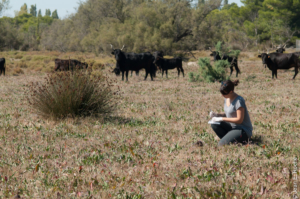Population dynamics of liver fluke in the Camargue
Objectives
The aim of this project is to better understand the population dynamics of the Common Liver Fluke (Fasciola hepatica) in the context of a network of wetlands strongly affected by people in the Camargue. There are two components of this research:
- A study on the diversity of this parasite between and within its different compartments: intermediate hosts (freshwater molluscs) and definitive hosts (wild and domestic mammals);
- To understand how these dynamics are affected by human factors: water management, contacts between wild and domestic species, utilisation of pesticides and anti-parasite treatments.
Actions and methodology
Various methodologies are used in function of the nature of the Common Liver Fluke hosts:
For intermediate hosts:
- Molluscs are collected on the Tour du Valat Estate;
- Parasites are found and dissected;
- Molluscs are genetically characterised to understand their population structure.
For definitive hosts:
- Dissection of the livers of Tour du Valat cattle at the slaughterhouse, and of wild boar and coypus killed by hunting or found dead on the Estate;
- Genetic analysis of the parasites collected to study the flows of parasites within our herd and between it and wildlife.
Results
In the framework of Émeline Sabourin’s doctoral thesis, undertaken since 2015, we have observed that the cattle not treated at the Tour du Valat seem to be in good health despite a high parasite load and a high rate of infection by F. hepatica (> 90%). We have also observed a significant prevalence in wildlife (30% for coypus). Our study of Common Liver Fluke shows that there is significant genetic diversity, that the infection is very common on the Estate, and that there is no clear separation between the liver flukes found in cattle and those found in wildlife. These results suggest that the parasites seem to circulate indifferently on the Estate between cattle, Wild Boar, and Coypu, with no obvious barrier between there different species of hosts, and also that the coypus always seem to get infected at the same place.
Video
Explication du cycle de la fasciolose (Explanation of the Life Cycle of the Liver Fluke) by Émeline Sabourin and Miguel Navascués (in French).
Team
- Project leader: Marion Vittecoq [1]
- Staff involved: Thomas Blanchon [2], Émilie Laurent [3], Olivier Boutron [4]
- Themes: EcoHealth & Wetlands Dynamics and Water Management
- Date of project: Since 2015
Partners
Technical partners
- UMR (CNRS/IRD/University of Montpellier) MIVEGEC [5]
- Pedro Kouri National Institute of Tropical Medicine [6]
- Universidad Nacional del Sur (Argentina) [7]
Financial partners
- Labex – Cemeb [8]
